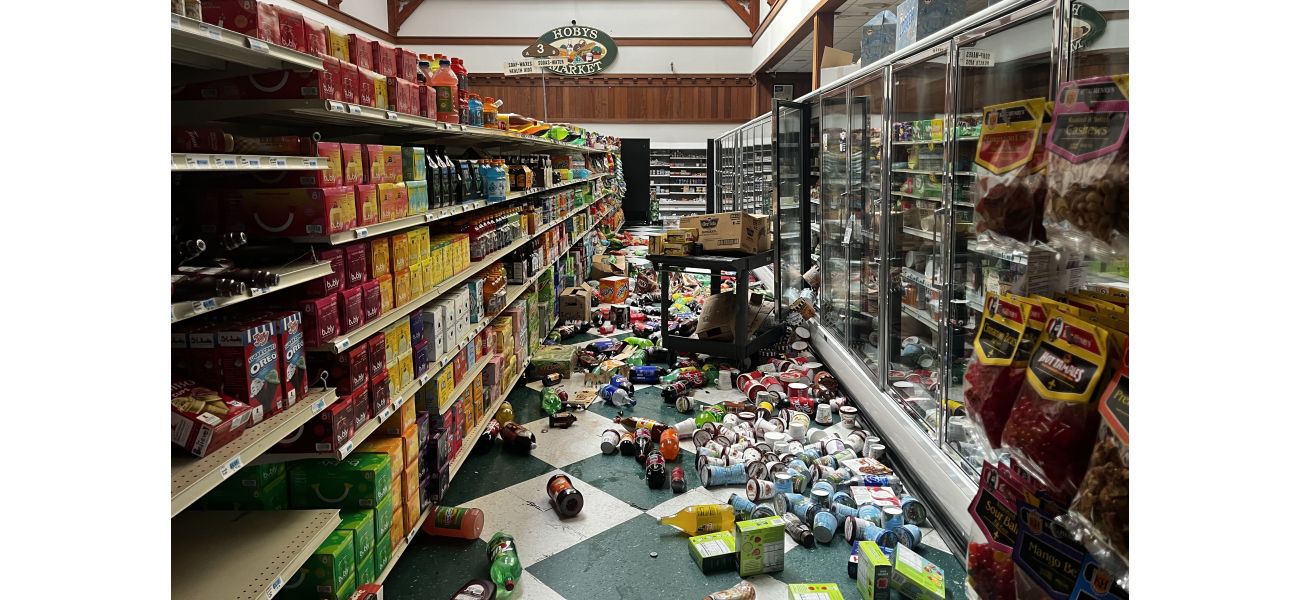Experts rush to study Humboldt County coast for insight on future earthquakes.
Scientists gather information on land and in the air to potentially protect lives in the future.
December 7th 2024.

In the days following a powerful 7.0 magnitude earthquake that struck California's Northern coast on Thursday, scientists are in a race against time to install sensors in the rugged mountains and river basins of the region. Their hope is to gather more information about the fault zone that poses a major threat to Mendocino and Humboldt counties.
One of the scientists, Tim Clements from the U.S. Geological Survey's Earthquake Science Center at Moffett Field, explains their goal, "We want to capture as many aftershocks as possible to get a better understanding of what's happening on the Mendocino Fault off the coast, where the ground ruptured."
While some scientists are using satellite technology to scan the area for any signs of landslides or damaged roads, others are on the ground looking for debris flows and landslides. In the Bay Area, crews are also measuring how the earthquake triggered small movements in the region's faults. According to research geologist Austin Elliott from the USGS Earthquake Science Center in Oakland, the Hayward fault was found to have moved a fraction of an inch.
The earthquake, which struck at 10:44 a.m. on Thursday, was the largest in California since a magnitude 7.1 hit the town of Ridgecrest in Kern County in 2019. The epicenter of this week's quake was located under the Pacific Ocean, approximately 40 miles off the coast of the historic town of Ferndale.
In Humboldt County, residents are now dealing with the aftermath of the earthquake, with some businesses and homes suffering damage. However, the major public infrastructure in the area appears to have avoided extensive damage, according to the Eureka Times-Standard. Some stores are temporarily closed for repairs and cleanup due to cracked windows, broken pipes, fallen ceiling tiles, and damaged inventory.
One resident, Jim Campbell-Spickler, who was perched on top of a tall redwood Christmas tree at the Sequoia Park Zoo when the earthquake hit, shared his experience, "What are the odds of that? I had my feet on a branch, and I could feel the power of the earthquake through my feet on the tree." He described feeling the tree move with each wave of the earthquake, as if something had collided with it, causing it to resonate.
This earthquake also provided another major test for the West Coast ShakeAlert earthquake early warning system, and it was a success. The system warned an estimated 5 million residents between Salinas and Lincoln City, Oregon, with a loud alarm and instructions to drop, cover, and hold on. Robert-Michael de Groot from the U.S. Geological Survey in Pasadena explains, "ShakeAlert was very accurate, initially reporting a 6.9 magnitude quake." After more than a decade of development, the ShakeAlert System now has over 1,500 earthquake sensors in California, Oregon, and Washington, with plans to have over 2,000 sensors by the end of 2025.
De Groot adds, "The system did exactly what it was supposed to do." An estimated 5 million people received alerts from ShakeAlert's delivery partners, including FEMA's wireless emergency alert system, the MyShake app developed by UC Berkeley, and Google's Android Earthquake Alert system.
With a one in 20 chance of a magnitude 6 earthquake occurring in the next week, Clements reminds us that many of the region's communities are built on soft mud of river basins, making them vulnerable to aftershocks.
John Oswald and Spencer Watkins, engineering geologists from the California Geological Survey, were on the ground assessing damage to a road in Humboldt County. The fault responsible for the earthquake is located in a restless region where two tectonic plates, the Gorda and Pacific, converge. Known as the Mendocino Fault, it is considered part of the Cascadia subduction zone that extends further north along the coast. This area is known for frequent earthquake activity due to its complex plate interactions.
Fortunately, no tsunami was triggered, as initially feared. This is because the earthquake occurred on a "strike-slip" fault, where two plates slide past each other horizontally, resulting in minimal vertical displacement of the seafloor. All of the Bay Area's faults, including the Mendocino Fault, are strike-slip faults.
However, the devastating tsunami that struck Japan in 2011 was caused by a different type of earthquake. De Groot explains, "Japan's 8.9-magnitude earthquake occurred in a subduction zone, where one tectonic plate slides beneath another."
When the earthquake hit on Thursday, scientists at the USGS's Moffett Park offices were quick to gather and meet in the hallway. As Clements says, "There's a lot to do." Some teams are heading up the coast to bury battery-powered sensors that can transmit data in real-time. Others are using nodal seismometers, which are quicker and easier to install than traditional seismometers, to measure aftershocks. And some teams are studying the response of distant faults in the Bay Area, such as the Hayward, San Andreas, and Calaveras faults, to the earthquake. Their goal is to better understand the relationship between these different types of motions.
Clements concludes, "With each earthquake, we can learn more about the underlying physics and better predict and understand the seismic hazard risk going forward."
One of the scientists, Tim Clements from the U.S. Geological Survey's Earthquake Science Center at Moffett Field, explains their goal, "We want to capture as many aftershocks as possible to get a better understanding of what's happening on the Mendocino Fault off the coast, where the ground ruptured."
While some scientists are using satellite technology to scan the area for any signs of landslides or damaged roads, others are on the ground looking for debris flows and landslides. In the Bay Area, crews are also measuring how the earthquake triggered small movements in the region's faults. According to research geologist Austin Elliott from the USGS Earthquake Science Center in Oakland, the Hayward fault was found to have moved a fraction of an inch.
The earthquake, which struck at 10:44 a.m. on Thursday, was the largest in California since a magnitude 7.1 hit the town of Ridgecrest in Kern County in 2019. The epicenter of this week's quake was located under the Pacific Ocean, approximately 40 miles off the coast of the historic town of Ferndale.
In Humboldt County, residents are now dealing with the aftermath of the earthquake, with some businesses and homes suffering damage. However, the major public infrastructure in the area appears to have avoided extensive damage, according to the Eureka Times-Standard. Some stores are temporarily closed for repairs and cleanup due to cracked windows, broken pipes, fallen ceiling tiles, and damaged inventory.
One resident, Jim Campbell-Spickler, who was perched on top of a tall redwood Christmas tree at the Sequoia Park Zoo when the earthquake hit, shared his experience, "What are the odds of that? I had my feet on a branch, and I could feel the power of the earthquake through my feet on the tree." He described feeling the tree move with each wave of the earthquake, as if something had collided with it, causing it to resonate.
This earthquake also provided another major test for the West Coast ShakeAlert earthquake early warning system, and it was a success. The system warned an estimated 5 million residents between Salinas and Lincoln City, Oregon, with a loud alarm and instructions to drop, cover, and hold on. Robert-Michael de Groot from the U.S. Geological Survey in Pasadena explains, "ShakeAlert was very accurate, initially reporting a 6.9 magnitude quake." After more than a decade of development, the ShakeAlert System now has over 1,500 earthquake sensors in California, Oregon, and Washington, with plans to have over 2,000 sensors by the end of 2025.
De Groot adds, "The system did exactly what it was supposed to do." An estimated 5 million people received alerts from ShakeAlert's delivery partners, including FEMA's wireless emergency alert system, the MyShake app developed by UC Berkeley, and Google's Android Earthquake Alert system.
With a one in 20 chance of a magnitude 6 earthquake occurring in the next week, Clements reminds us that many of the region's communities are built on soft mud of river basins, making them vulnerable to aftershocks.
John Oswald and Spencer Watkins, engineering geologists from the California Geological Survey, were on the ground assessing damage to a road in Humboldt County. The fault responsible for the earthquake is located in a restless region where two tectonic plates, the Gorda and Pacific, converge. Known as the Mendocino Fault, it is considered part of the Cascadia subduction zone that extends further north along the coast. This area is known for frequent earthquake activity due to its complex plate interactions.
Fortunately, no tsunami was triggered, as initially feared. This is because the earthquake occurred on a "strike-slip" fault, where two plates slide past each other horizontally, resulting in minimal vertical displacement of the seafloor. All of the Bay Area's faults, including the Mendocino Fault, are strike-slip faults.
However, the devastating tsunami that struck Japan in 2011 was caused by a different type of earthquake. De Groot explains, "Japan's 8.9-magnitude earthquake occurred in a subduction zone, where one tectonic plate slides beneath another."
When the earthquake hit on Thursday, scientists at the USGS's Moffett Park offices were quick to gather and meet in the hallway. As Clements says, "There's a lot to do." Some teams are heading up the coast to bury battery-powered sensors that can transmit data in real-time. Others are using nodal seismometers, which are quicker and easier to install than traditional seismometers, to measure aftershocks. And some teams are studying the response of distant faults in the Bay Area, such as the Hayward, San Andreas, and Calaveras faults, to the earthquake. Their goal is to better understand the relationship between these different types of motions.
Clements concludes, "With each earthquake, we can learn more about the underlying physics and better predict and understand the seismic hazard risk going forward."
[This article has been trending online recently and has been generated with AI. Your feed is customized.]
[Generative AI is experimental.]
0
0
Submit Comment





